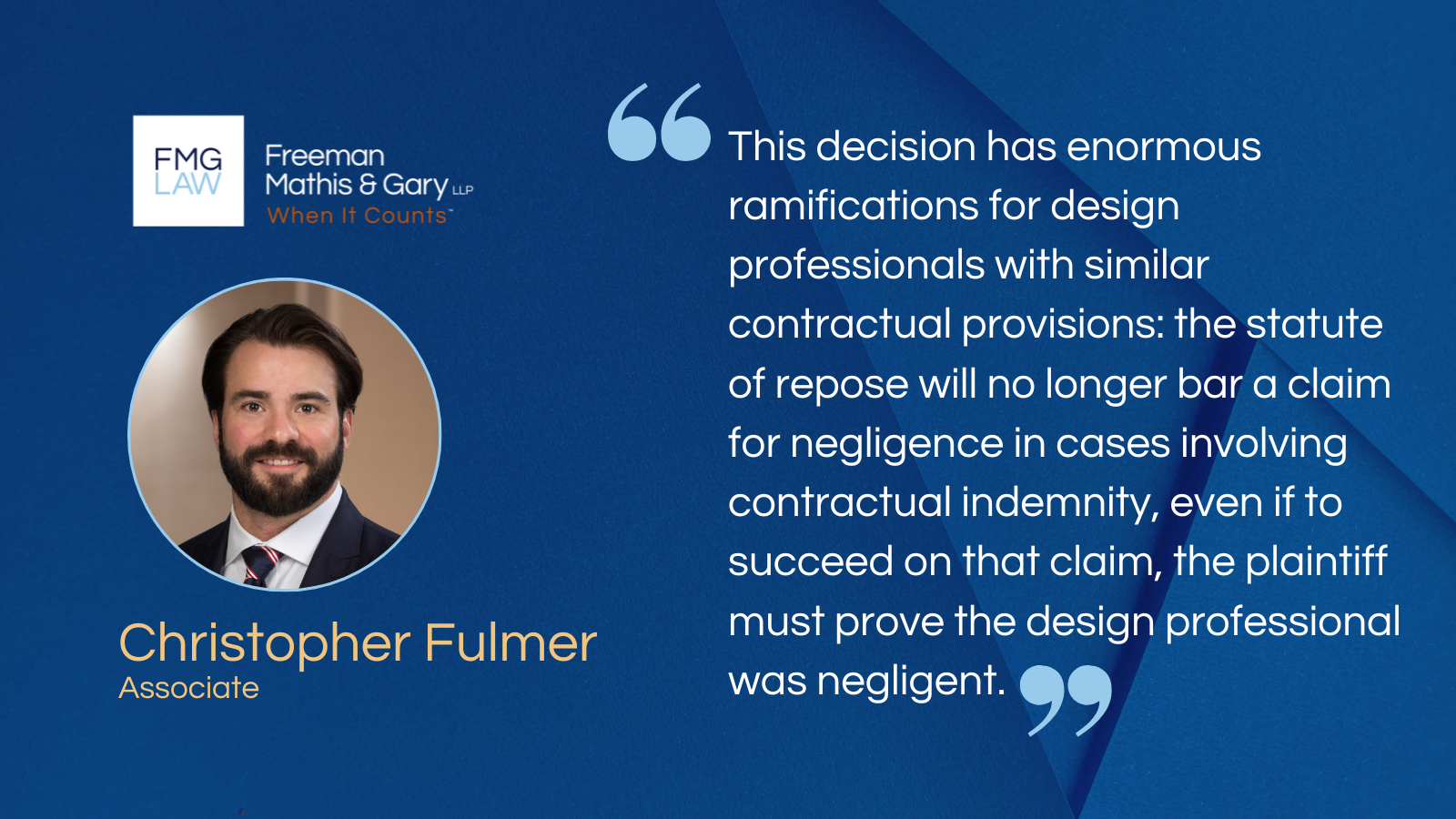BlogLine
Unreposed: No rest after six years in Massachusetts
5/13/25

In a pivotal decision for construction law in Massachusetts, the Supreme Judicial Court (SJC) recently addressed the application of the state’s statute of repose in Trustees of Boston University v. Clough, Harbour & Associates LLP. The case centered on whether the Massachusetts statute of repose—intended to limit the time within which actions may be brought against design professionals and contractors1—is applicable to contractual indemnity provisions that require design professionals to indemnify owners for harm caused by a negligent design. The SJC held that the plaintiff’s claim was contractual in nature, and thus, the Commonwealth’s six-year statute of repose barring tort actions does not bar it.
In 2012, the plaintiff, Boston University (the “University”), entered into a contract with the defendant, architectural firm Clough, Harbour & Associates LLP (“CHA”), to design a synthetic turf athletic field located above a parking structure, also designed by CHA. The contract included an indemnity provision which provided: “To the fullest extent permitted by law, [CHA] shall indemnify … [the University] … from and against any and all … expenses, including, but not limited to, reasonable attorney’s fees, to the extent caused … by the negligence of [CHA].” Trs. of Bos. Univ. v. Clough, Harbour & Assocs. LLP, 495 Mass. 682, 683, 255 N.E.3d 596, 598 (2025) (emphasis added).
The field opened in 2013, and due to CHA’s design, the field developed depressions in the surface that made it unfit for athletic events. When the University demanded CHA indemnify it for the costs of remediating the deficiencies, CHA declined. Six years after the field opened, the University sued CHA for breach of the indemnity provision.
CHA moved for and was granted summary judgment on the basis “that the tort statute of repose, which eliminates a cause of action in tort six years after the opening of an improvement to real estate…barred the university’s indemnification claim.” Id. at 684. In its April 16 decision, the SJC reversed the lower court.
On appeal, CHA argued that the tort statute of repose barred the University’s indemnification claim, “which indisputably was filed more than six years after the opening of the athletic field, because, although the claim ostensibly is based in the parties’ contract, the contractual provision requires CHA to indemnify the university for CHA’s negligence and a negligence action is itself an action in tort.” Id. However, the Court noted its previous decision in Gomes, in which the SJC held that a third-party claim against an architect to enforce an indemnity provision was not barred by the statute of repose where the underlying claim by the plaintiff was for negligence because the indemnity claim itself was contractual. Gomes v. Pan Am. Assocs., 406 Mass. 647, 648, 549 N.E.2d 1134, 1135 (1990).
Elaborating further, the SJC cited well-established Massachusetts case law that the tort “statute of repose ‘does not apply to contract actions,’ and ‘expressly provides a limitation only for actions of tort.’” Trs. of Bos. Univ., 495 Mass. at 685 (citing Klein v. Catalano, 386 Mass. 701, 718, 437 N.E.2d 514 (1982)). The Court emphasized that a key difference between an action in tort and an action in contract is that in the latter, the standard of performance is governed by contract, rather than imposed by law. Id. citing Anthony’s Pier Four, Inc. v. Crandall Dry Dock Eng’rs, Inc., 396 Mass. 818, 823, 489 N.E.2d 172 (1986).
Finally, the Court distinguished the elements of the University’s contractual indemnification claim from a claim for negligence: “To prevail on its claim, the university must show the existence of a valid and enforceable indemnification clause, the occurrence of an event triggering the duty to indemnify, the provision of adequate notice to the indemnitor and the failure of the indemnitor to fulfill its obligation as specified in the indemnification clause.” Id. at 687. Or put another way, to prove “the occurrence of an event triggering the duty to indemnify,” the University must prove CHA was negligent.
This decision has enormous ramifications for design professionals with similar contractual provisions: the statute of repose will no longer bar a claim for negligence in cases involving contractual indemnity, even if to succeed on that claim, the plaintiff must prove the design professional was negligent. Architects and engineers should be wary of contractual language that imposes obligations related to their potential negligence, as the statute of repose will not limit the time in which claims can be brought against them. Further, design professionals may now be subject to liability if the contract notes that the exposure is created not simply by their adjudicated negligence, but by the professional’s promise to indemnify its client for such negligence.
For any questions or further clarification, please contact Christopher J. Fulmer at christopher.fulmer@fmglaw.com or your local FMG attorney.
Information conveyed herein should not be construed as legal advice or represent any specific or binding policy or procedure of any organization. Information provided is for educational purposes only. These materials are written in a general format and are not intended to be advice applicable to any specific circumstance. Legal opinions may vary when based on subtle factual distinctions. All rights reserved. No part of this presentation may be reproduced, published or posted without the written permission of Freeman Mathis & Gary, LLP.
- Under Massachusetts law, the statue of repose provides that an “[a]ction of tort for damages arising out of any deficiency or neglect in the design, planning … of an improvement to real property … shall be commenced,” no more than six years “after the earlier of the dates of: (1) the opening of the improvement to use; or (2) substantial completion of the improvement.” M.G.L. c. 260, § 2B. ↩︎
Share
Save Print
